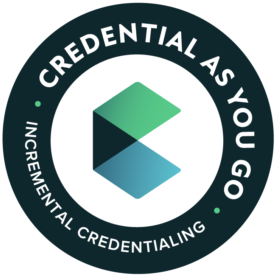The policy landscape is a crowded, layered, and significant component of the learn-and-work ecosystem. Policy is a broad category that encompasses laws, regulations, procedures, administrative actions, rules, incentives, and voluntary practices of governments and other institutions. Policy decisions are frequently reflected in resource allocations and in accountability processes.
An array of policy bodies may impact the move to an incremental credentialing system in the U.S:
The following focuses on examples of policy that impact incremental credentialing from federal, state, state system of higher education/coordinating boards, and accreditation bodies. Additional information will be added soon on other policy bodies that impact incremental credentialing.
Examples of key federal policy areas related to the learn and work ecosystem include a variety of tools the federal government has to influence the ecosystem, federal financial aid to learners, data collection, and workforce development.
[ninja_tables id=”2655″]
States set policy for their educational systems, and provide policies which impact their workforce and employers. Examples of state policy include Governor-led statewide financial assistance programs for short-term postsecondary courses and programs; legislation actions to support credentialing strategies; higher education system approaches to adopt micro- credential policies; and remedial education policies.
[ninja_tables id=”2657″]
State systems of higher education and coordinating boards play a major role in policy. They typically develop and implement postsecondary policy in alignment with federal and state statute; administer academic, financial aid and workforce programs to include the review and approval of academic programs and research centers; commission and conduct research and analysis and complete data reports; set tuition rates, and administer funding formulas and allocate funds. Governors often play a key role in these entities by appointing their CEOs.
[ninja_tables id=”2658″]
Accreditation plays an important role in the policy world. Higher education in the U.S. relies on accreditation to ensure quality and foster a culture of continuous improvement.
[ninja_tables id=”2659″]
References

Credential As You Go has acquired three phases of funding to date. Lumina Foundation funded Phase I, resulting in the Incremental Credential Framework for testing. The Institute of Education Sciences, U.S. Department of Education funds Phase II (Grant R305T210063), which focuses on rapid prototyping of and research on incremental credentials with a national campaign. An anonymous private donor fund at the Program on Skills, Credentials & Workforce Policy at George Washington University funds the development of the prototype Learn and Work Ecosystem Library. Walmart funds Phase III, which focuses on systems change for expansion and sustainability of incremental credentials. The opinions expressed are those of the authors and do not represent views of Lumina Foundation, Institute of Education Sciences, the U.S. Department of Education, Walmart, or George Washington University.